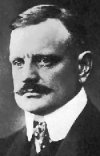
Jean Sibelius
Today, the term
Nationalism is almost a dirty word, implying fanaticism and a patriotic excuse for violence. At the turn of the twentieth century, however, Nationalism was a heroic movement, the speaking up of little cultures against repression.
When Jean Sibelius was born, Finland was under the control of Russia. Its people were expected to speak Swedish and the Finnish language and culture was for peasants only.
Jean Sibelius was sent to a Finnish-speaking school at the impressionable age of 11, and became aware of his country's rich literary tradition, especially the epic Finnish poetry known as
Kalevala.
Later in life his patriotic feelings were fueled by his objection to the "Russianization" of his country. In 1899 he wrote music to accompany a poem full of patriotic fervour called
The Melting of the Ice on the Ulea River from which he later extracted 4 episodes and reworked them into a tone poem. At first, under strict censorship, he called this tone poem
Impromptu but it later became known as
Finlandia and has since become Sibelius' best-known work and Finland's unofficial national anthem.
Finlandia is a rousingly patriotic work, at first quiet, unsure, almost threatening, a depiction of the czarist darkness engulfing Finland. Later it progresses through hope, indignation and jubilation, and culminates in the well-known, much-loved hymn-like theme that bring tears to Finns eyes. Like Gustav Holst's
Jupiter from
The Planets Suite, this is one of classical music's great melodies, stirring and elevating even for non-Finns.

Jean Sibelius
Sibelius'
Second Symphony is a later and much more substantial work, and established Sibelius as the great Northern symphonist. Simple folk-like melodies continue the nationalist mood of
Finlandia. Firmly rooted in Romantic soil, the
Second Symphony shows hints of Sibelius' later style. Short fragments of music coalesce into large themes, early conflict and angst later resolve into a triumphant finale. And most of all, music saturated in Sibelius' unique color scheme, a Northern pallette of harmonies and emotions.
The first movement starts out pastoral but quickly becomes dark and ominous. The bassoons in the second movement bring to mind a funeral march, intense and tragic at the same time. The pace quickens with the last two movements, the
Scherzo rushing headlong into the heroic
Finale, the final minutes of which will take your breath away.
Finlandia and the
Second Symphony are among Sibelius' best-known works, and there is no better introduction to his music. They evoke struggle, and heroism, the Northern winter ice, and the warmth of spring.
And here lies a problem. Can one play Sibelius without having experienced the long dark nights, seeing the iced lakes and forests, understood the Finnish mentality? In short, can non-Finns play Sibelius? Joel Levi and the Cleveland Orchestra are technically perfect, the recording razor-sharp, but there seems to be something missing; maybe a bleakness or depth of feeling. While excellent, I get the feeling of this recording being not quite authentic. And at under 50 minutes, its not great value for a full price CD.
Please support Good-Music-Guide.com
by purchasing this CD using this link.

Track Listing
Jean Sibelius
Finlandia and Symphony no.2
Joel Levi
The Cleveland Orchestra
Symphony no.2 in D, Opus 43
- I. Allegretto
- II. Tempo Andante, Ma Rubato
- III. Vivacissimo IV. Finale
- Finlandia opus 26